The key for a successful cultivation of tuberous Drosera is to closely mimic they are subjected to in nature. For this reason we need to look at the conditions under which the tuberous drosera grow in Australia.

Drosera aff. bulbosa El Caballo Blanco form
The key for a successful cultivation of tuberous Drosera is to closely mimic the conditions tuberous Drosera are subjected to in nature. Therefore we will first take a look onto the climatic conditions of the regons where the tuberous Droser are growing.
Nearly all the tuberous Drosera originate from semi-arid regions in the south-west of western Australia. These areas become hot and dry in the summer months, but are wet with moderate temperatures in the winter. The plants adapt to this extreme variation of conditions by growing during the winter and than developing subterraneous tubers before the hot and dry summer in order to survive the dry period.
Average Temperature [°C]
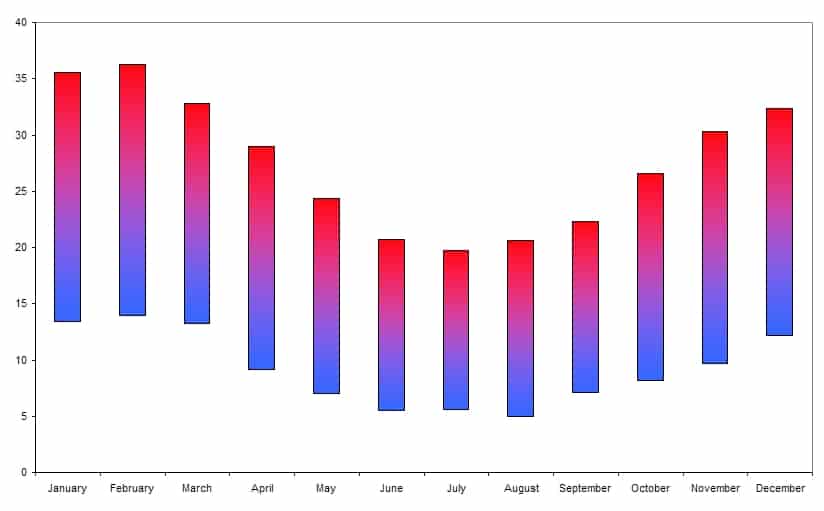
Average Temperature [°F]
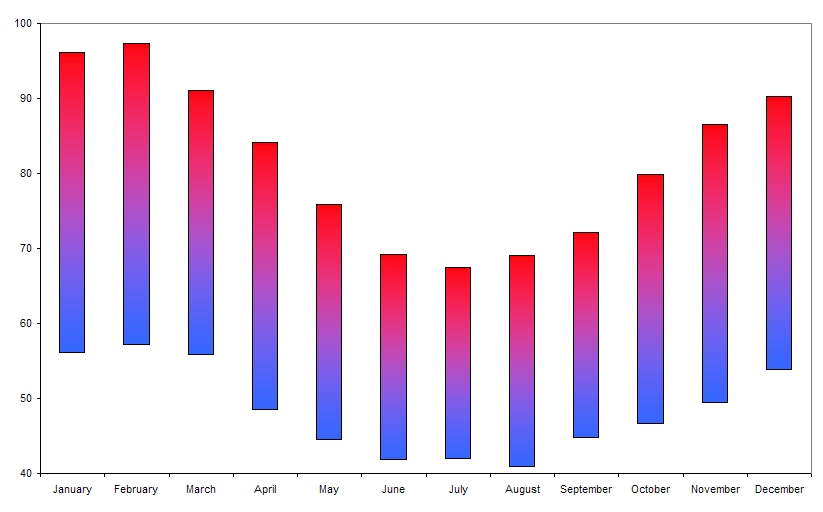
As summertime begins, temperatures begin to rise above 20 °C (70 °F) and the photoperiod reaches approximately 10 hours a day. At this time, all the parts of the plant above the ground begin dying and the subterraneous tubers are formed. Some species like Drosera gigantea form tubers up to 1,5 m (5 feet) deep in ground. At this depth, the temperatures are lower than on the surface and there is also residual moisture stored here, even though the surface is extremely dry, like a desert. When the winter time begins, bringing lower temperatures and substantial rainfalls, the tubers start to sprout again. At this time, the photoperiod is between 8 to 6 hours. The areas in which tuberous Drosera grow are usually very sandy.
Average Hours of Sunlight (Photoperiod) [h]
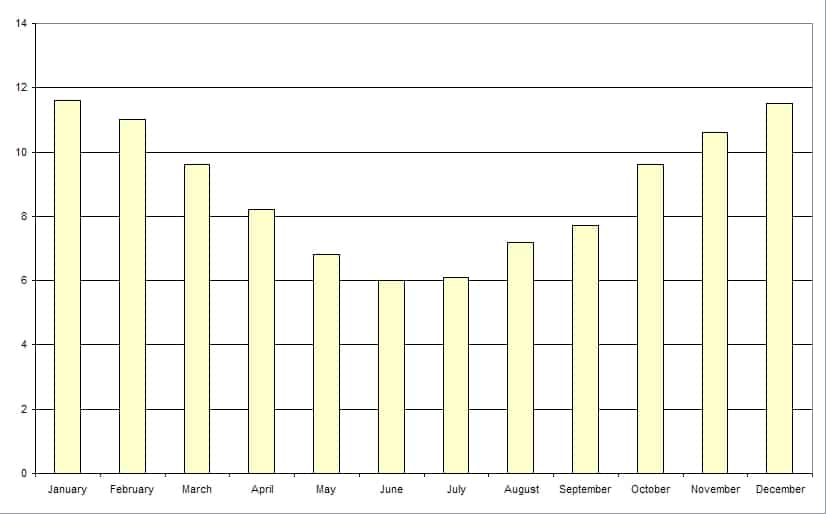
Average Hours of Cloudy days [h]
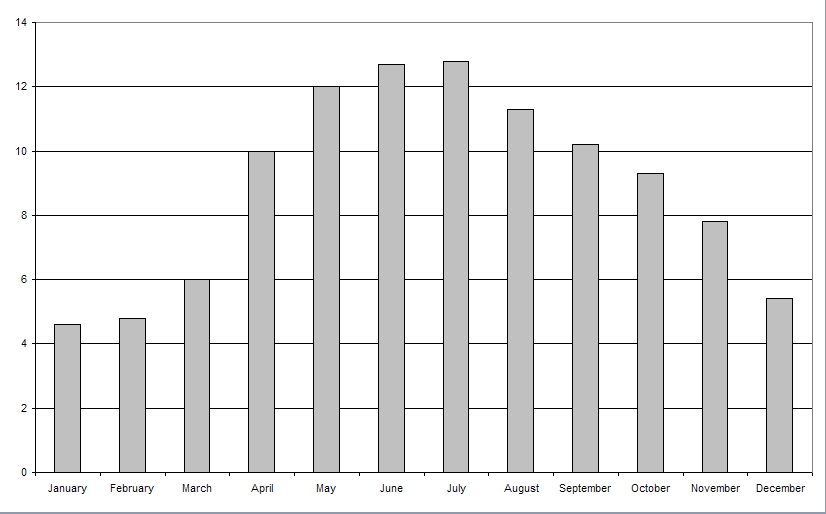
In winter, when the climate becomes more humid due to rainfall and the earth becomes wet again, the tuberous Drosera start to grow.
Average Rainfall [mm]
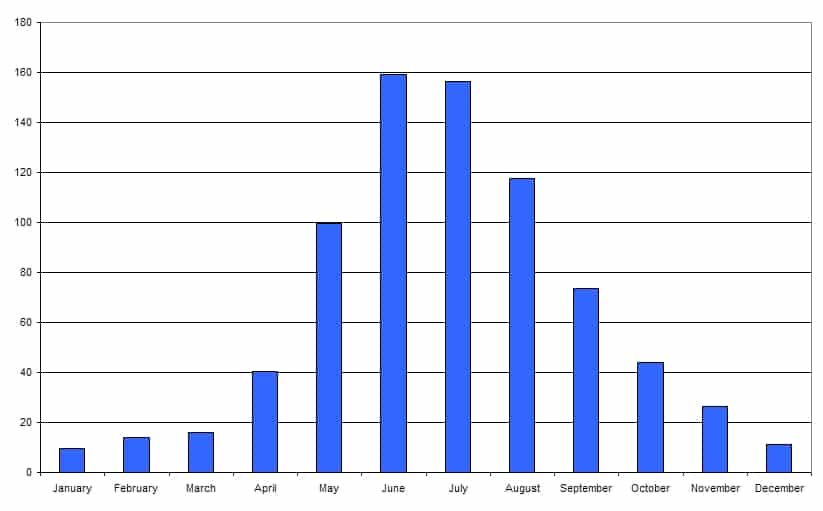
These charts show the summary statistics for Perth, Australia. The original data are from the Australian Government, Bureau of Meteorology.
The key for a successful cultivation of tuberous Drosera is to closely mimic the conditions tuberous Drosera are subjected to in nature. So we have to take care of the temperature, the humidity inside the pot and outside and the light.
Temperature
Tuberous Drosera are picky about the temperatures. If temperatures drop below 0°C(32°F) and the pot is freezing the plant will die and you can only hope that a few roots survive to build a new plant and that this plant becomes strong enough to form a tuber, when the growing period is over. If the temperature is only for some hours under 0°C (32°F) and not totally frozen even if the dew is freezing there is a chance that the tuberous Drosera survives.
On the other hand, if tuberous Drosera receive temperatures above 25 °C (75 °F) for one week or longer, the plants will think the dry summer is approaching. In response, they will begin to remove nutrients from the above ground parts of the plant in order to build a subterraneous tuber. At this time, it will appear that the plant is dying.
Therefore the temperatures during the growing season should be between 5 to 20 °C (40 and 70 °F). Mine are kept in the basement of my house at temperatures around 15 to 20 °C (70 °F) at daytime and 10 to 15 °C at nighttime hold winter long and this works well. In the dormancy season the temperatures should be above 20 °C (70-75°F) but also try avoid temperatures that are too hot. Don’t worry if there are some days with cooler temperatures, but this time shouldn’t be longer than a week or more, otherwise the tubers can start to sprout.
As you can see in the charts above the temperatures in the growing season are less than 75°F at daytime (25°C) with relevant rainfalls and about 8 to 6 hours sunlight. In the dormant season the temperatures are above 75 °F (25°C) with nearly no precipitation. If you can provide these conditions you will have fun time with your tuberous Drosera :).
Media moisture
In the winter, while the tuberous Drosera are growing, the media remains moist. The easiest way to keep the soil moist is by using the tray method, but make sure that the tubers remain above the water line. Usually this is not a problem since the tubers were planted mostly halfway up pot. But towards the end of the growing season, the secondary tubers develop and in some species (ex. D. gigante, D. rupicola), these tubers are formed deep in the pot. This is yet another reason to give your plants less water when the first signs of dormancy are observed. Usually, if I see that the plant starts to show signs of a beginning dormancy I put these plants in a separate tray, which is left completely dry. In the course of time, the watered tray becomes more and more empty and the dry one is filled up with pots, where the pots are left to dry.
The first time I grew tuberous Drosera, I made the mistake of keeping them in an active growing state for as long as possible. I thought as long as the plants are growing it is better to keep them moist, and I only stopped watering them when they were nearly brown. The result was that many of the tubers rotted. Keep in mind that at the time the first leaves becomes brown, the tubers have already started to form. I know it’s hard to see a healthy plant which seems to die of thirst and not to give it even one drop of water, but they expect and need this.
Than I have read that the pots shouldt be kept totally dry even with no residual humidity. I lost 3 tubers of Drosera zoneria! Some people say that this works well but I wouldt not recommend this. Remember that the plants are building tubers in order to suvive deep in the earth where there is a residual moisture and usually in the middle of the pot automatically a residual moisture will remain.
If the pots in the dry season really seems "too dry" for me than I spray some water onto them, but really very little.
Humidity
Generally tuberous Drosera are not so picky about the humidity. In the growing season (in habitat) there is between 60 and 80% relative humidity and that’s the range you should try to attain. Humidity can be controlled by a range of options- for example, there is about 100% humidity in a closed glass container and 20 - 50% in an open glass container in the house (depending on the time of year). While tuberous Drosera can grow in very low humidity, it is not recommended to let them grow open in the house without the tray method because they will produce little to no dew, and won't be able to digest insects/food as easily.
Light
Like nearly all Drosera, tuberous Drosera need a lot of light, but they don’t have very high requirements because they are usually growing in the cold season, when the light intensity is low. Plus the natural photoperiod is between 6 and 8 hours during the period that they are growing as you see in the chart above.
Growing Tuberous Drosera in a Greenhouse (or using additional lighting)
Therefore, if you grow them in a greenhouse at an appropriate temperature during the winter, you probably do not need any additional light. If the plants don't obtain full coloration under these conditions, this is not necessarily harmful (as long as the plants are still producing dew). If you desire to provide supplemental illumination, it is better to add the additional lighting while the sun is shining rather than extending the photoperiod.
Solely Using Artificial Light
Tuberous Drosera can be grown very well under artificial light, but in this case, the temperature needs to be monitored carefully. Most artificial lights produce heat (most notably T-5 fixtures). This can be a problem, since heat seems to be one of the most important factors that controls the biological clock of tuberous Drosera. Under artificial lighting, a constant photoperiod of 8 hours in the growing season works well. In the last 10 years I practiced successfully the following lighting scheme:
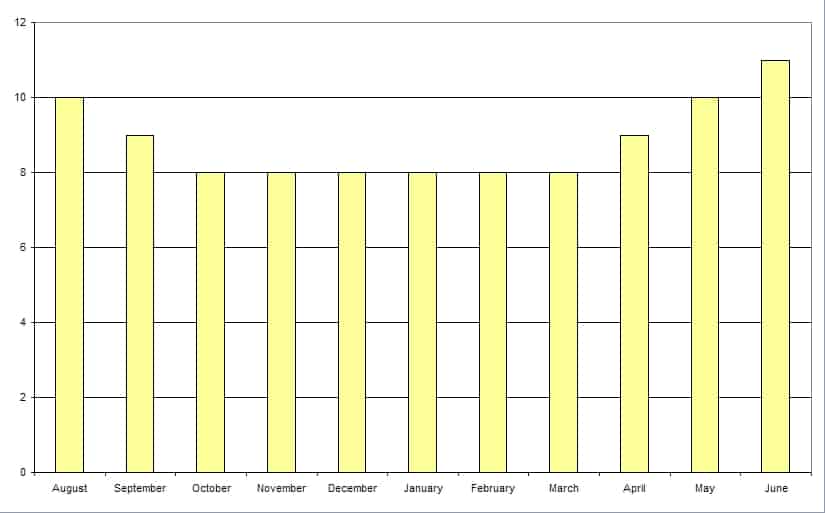
I keep all my tuberous drosera and also my pygmys and wintergrowing African species in winter, when the temperatures outside are too low, under artificial light. For this I use several shelves with T5 tubes. The more modern technology are LED lamps but a conversion is not cheap and technically demanding. Therefore it will probably take a while until I change everything to LED. If you are at the beginning of your wonderful career as a tuberous Drosera grower you should start with LED right away.
Attention: The handling of the electrical equipment is dangerous! If you do not have sufficient experience in this field, you should not build these things yourself from the scratch, but rather use commercially available, prefabricated LED tubes or LED strips.
Some Tips about the conditions
Some of the tuberous Drosera do not want to go to sleep! Therefore, apart from the naturally higher temperature in summer and the lack of water, I put the photoperiod for the last ones in June to 11 hours. However, this happens very rarely, as I usually place my plants on the terrace in April or may.
If you have the opportunity to put the tuberous Drosera somewhere outside in the garden, on a terrace or anything like that it is recommended to do it for the beginning and the end of the season. I put them to the terrace from about august to october/november until the minimal night temperature is not less than 5° C (40 °F). Then I take them under artificial light until march an when the night temperatures are higher than 5 °C I put them back onto the terrace. There they can follow the natural rhythm, but you have to take care about the following things:
At the end of the season they should not get too much sun at the beginning. The light intensity of a cloudy summer day is about 20000 lx and more or less the intensity you could and should get under artificial light. At a cloudless summer day in the middle of Europe or the USA you easily get 100000 lx.
Take care of too low temperatures (close to or under the freezing point) or too hot temperatures (25 °C / 75 °F or above) for a couple of days at the beginning of the season.
Take care that the humidity is not changing too fast. If they were in a more or less closed container they are accustomed to a high humidity. Adopt them in about 2 weeks to the humidity outside by keeping them first in a more or less closed container and then open the container day by day a little.
Take care, that they are protected against heavy rain while outside. This could be disastrous especially for fine, erect species like D. bicolor, D. zigzagia and so on and for seedlings. I usually let the more picky and rare species and the seedlings under artificial light all the time because I am afraid of loosing them. All the rest of my tuberous Drosera (and pigmy and wintergrowing african Drosera, too) are outside as soon as it is possible.
Now you should have an idea of the conditions under which your tuberous Dorsera will grow well at your home. With the more practical things like the pots, the substrate, how and how often the plants are watered or if you should feed them you can continue here.